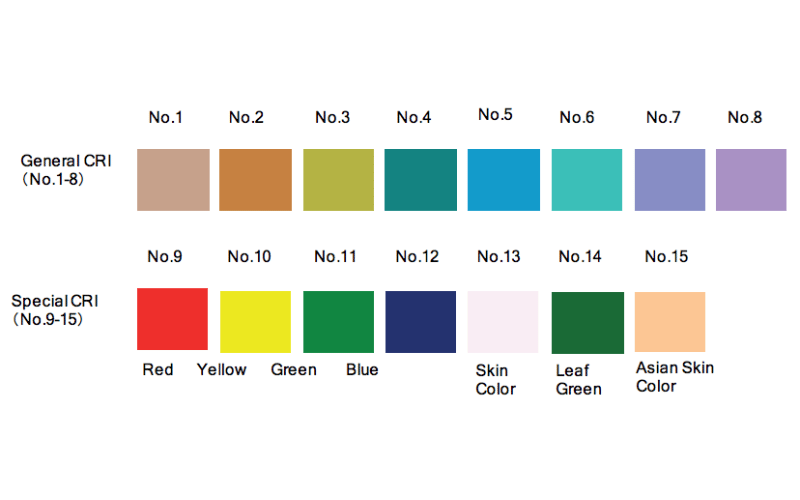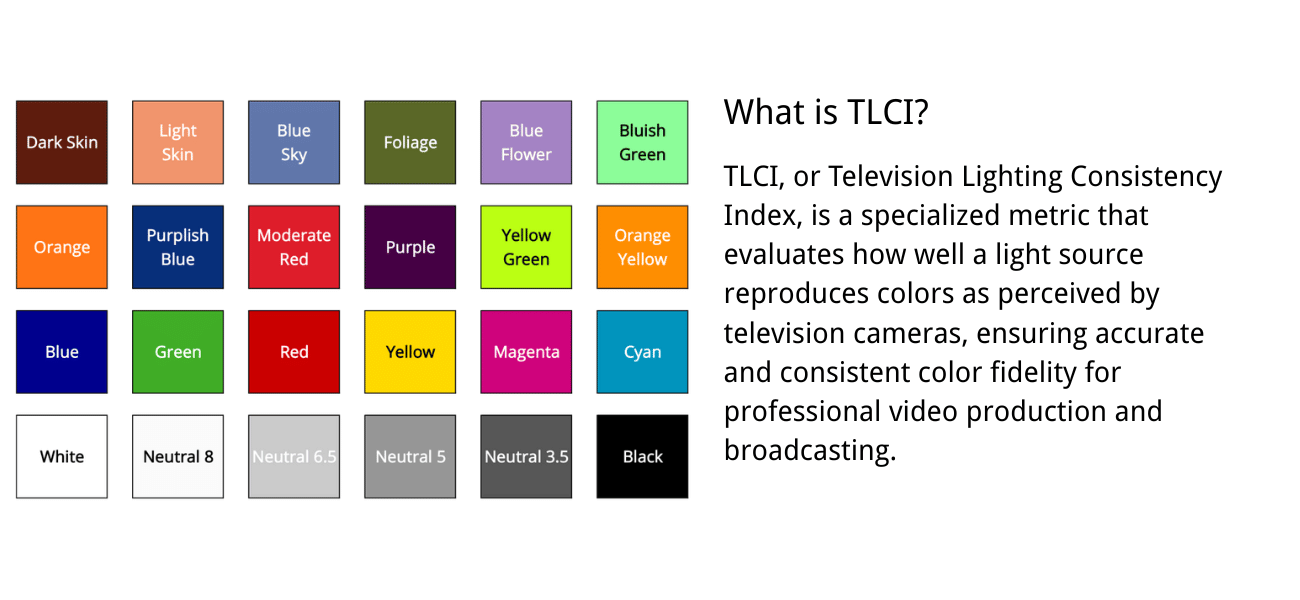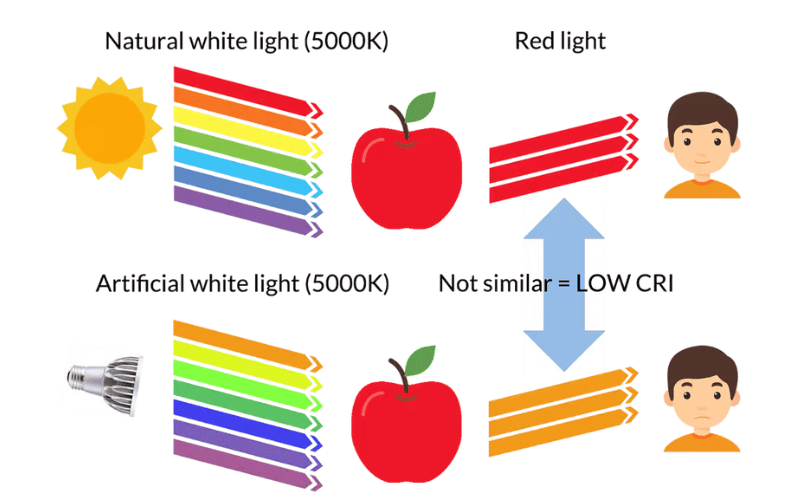In the world of professional lighting, achieving accurate and consistent color representation is essential for creating visually stunning and engaging experiences. Whether it’s a live sports broadcast, a film set, or a retail environment, the quality of lighting can make or break the final result. Two key metrics—Television Lighting Consistency Index (TLCI) and Color Rendering Index (CRI)—play a pivotal role in evaluating and optimizing lighting performance. This article dives deep into the differences between TLCI and CRI, their practical applications, and how they impact industries like broadcasting, video production, and sports lighting. By understanding these metrics, professionals can make informed decisions to ensure their lighting setups meet the highest standards of quality and precision.
Table of Contents
ToggleUnderstanding TLCI and CRI
What is TLCI?
The Television Lighting Consistency Index (TLCI) is a specialized metric designed to evaluate how well a light source reproduces colors as seen through a camera. Unlike general-purpose metrics, TLCI focuses on the needs of video production and broadcasting professionals. For example, in a live news broadcast, lighting with a high TLCI score ensures that skin tones appear natural and consistent across different camera angles, reducing the need for time-consuming color corrections in post-production. This makes TLCI an essential tool for cinematographers, lighting designers, and broadcasters who prioritize on-camera color accuracy.
What is CRI?
The Color Rendering Index (CRI) measures how accurately a light source reveals the true colors of objects compared to a natural light source, such as sunlight. It is widely used in industries like retail, photography, and interior design, where human perception of color is critical. For instance, in a high-end clothing store, lighting with a CRI of 90 or above ensures that fabrics appear vibrant and true to their actual colors, enhancing the shopping experience. However, CRI is less effective for video production because it doesn’t account for how cameras perceive light, making it a less precise tool for broadcast applications.
Comparing TLCI and CRI
While both TLCI and CRI measure color accuracy, they are optimized for different purposes and contexts:
-
Purpose: TLCI is tailored for video and broadcast environments, ensuring colors appear accurate on camera. CRI, on the other hand, is designed for general lighting applications where human color perception is the priority.
-
Measurement Method: TLCI evaluates how a light source interacts with camera sensors, simulating how colors will appear on screen. CRI measures how light affects the human eye’s perception of color, making it ideal for spaces like art galleries or retail stores.
-
Practical Applications: Use TLCI for projects involving cameras, such as live sports broadcasts, film sets, or studio productions. For example, a high-TLCI light ensures that the green of a soccer field and the colors of team jerseys remain vibrant and true to life on screen. CRI is better suited for environments like museums, where accurate color perception enhances the display of artwork.
-
When to Prioritize: Choose TLCI when working in video production to minimize post-production corrections and ensure consistent on-camera visuals. Opt for CRI when designing spaces for human interaction, such as restaurants or showrooms, where the goal is to create a visually pleasing atmosphere.
By understanding the strengths and limitations of each metric, professionals can make informed decisions about which tool to use for their specific needs. For instance, a lighting designer working on a film set would prioritize TLCI, while a retail store owner would focus on CRI to enhance the customer experience.
TLCI in Broadcasting and Lighting Solutions
Television Lighting Consistency Index
The Television Lighting Consistency Index (TLCI) is a critical metric for achieving broadcast-quality lighting. It evaluates how accurately a light source reproduces colors as seen through a camera, ensuring that visuals remain true to life. For example, in a live political debate, high-TLCI lighting ensures that skin tones appear natural and consistent across all camera angles, avoiding the need for extensive color correction in post-production. Unlike general lighting metrics, TLCI is specifically designed for video production, making it indispensable for professionals in broadcasting, filmmaking, and live events.
Importance of TLCI in Broadcasting
In broadcasting, where visual fidelity is paramount, even minor color inconsistencies can disrupt the viewer’s experience. For instance, during a live sports event, poor lighting can cause team uniforms to appear dull or inaccurately colored on screen. High-TLCI lighting ensures that colors remain vibrant and true to their original appearance, enhancing the overall broadcast quality. By using lighting with a TLCI score of 85 or higher, broadcasters can minimize post-production adjustments, saving both time and resources while delivering consistent, high-quality visuals.
How TLCI Affects Color Rendition
TLCI has a direct impact on the visual quality of video production by ensuring accurate color rendition. For example, in a televised cooking show, poor lighting might make food appear unappetizing or unnatural on screen. High-TLCI lighting eliminates these issues, ensuring that the rich reds of a tomato or the golden brown of a roasted chicken look as appealing on camera as they do in real life. This level of accuracy is crucial for maintaining audience engagement and delivering professional-grade visuals.
Measuring TLCI in Lighting Solutions
Evaluating TLCI in lighting products requires specialized tools and methods. Spectroradiometers and TLCI-specific software are commonly used to measure a light source’s performance. These tools simulate how cameras perceive light, providing a detailed score that helps professionals make informed decisions. For instance, a lighting designer working on a live concert broadcast might use a spectroradiometer to ensure that stage lighting not only enhances the performers but also translates accurately on camera. Regular testing and calibration of lighting setups are essential to maintain consistent TLCI performance across different projects.
Lighting Metrics and Their Practical Impact
Key Metrics for Evaluating Lighting Quality
When evaluating lighting quality, three key metrics stand out: the Television Lighting Consistency Index (TLCI), Color Rendering Index (CRI), and Correlated Color Temperature (CCT). Each serves a unique purpose:
- TLCI: Essential for video production, TLCI ensures accurate color reproduction on camera. For example, in a multi-camera film shoot, high-TLCI lighting guarantees that colors remain consistent across all angles, reducing the need for post-production corrections.
- CRI: CRI measures how well a light source reveals true colors to the human eye, making it ideal for environments like retail stores or art galleries. For instance, a CRI of 90 or higher ensures that clothing in a boutique appears vibrant and true to its actual color.
- CCT: Correlated Color Temperature defines the color appearance of light, ranging from warm (yellowish) to cool (bluish) tones. A CCT of 3200K is often used for indoor settings like theater stages, while 5600K is preferred for outdoor shoots to mimic natural daylight.
By understanding and combining these metrics, professionals can select lighting solutions tailored to their specific needs, whether for broadcasting, retail, or architectural design.
Understanding High TLCI Values
High TLCI scores are critical for professional lighting setups, particularly in broadcasting and video production. A TLCI score above 85 is considered excellent, as it ensures minimal color distortion on camera. For example, during a live sports broadcast, high-TLCI lighting ensures that the green of the field and the colors of team uniforms remain vibrant and true to life, even under intense stadium lights. This consistency not only enhances the viewing experience but also reduces the time and cost associated with post-production adjustments. Professionals working in live events or studio productions should prioritize lighting fixtures with high TLCI ratings to maintain visual fidelity.
Role of CCT in Lighting Performance
Correlated Color Temperature (CCT) plays a significant role in how TLCI and CRI perform in different environments. For instance:
- Indoor Settings: A CCT of 3200K (warm light) is commonly used in indoor environments like news studios or theater stages, where a cozy and natural ambiance is desired.
- Outdoor Shoots: A CCT of 5600K (daylight) is ideal for outdoor events or shoots, as it mimics natural sunlight and ensures accurate color rendition in open spaces.
- Mixed Environments: In spaces with both natural and artificial light, such as a hybrid indoor-outdoor set, balancing CCT with high TLCI and CRI values ensures consistent and accurate lighting.
The interaction between CCT, TLCI, and CRI determines how well colors are rendered under specific conditions. For example, in a cooking show filmed indoors, using a warm CCT with high TLCI ensures that food looks appetizing and natural on camera. Professionals should carefully match the CCT to the environment and intended visual effect to achieve optimal results.
TLCI in Sports Lighting
Sports Lighting Considerations
Lighting for sports events and venues presents unique challenges that require precision and consistency. The lighting must ensure clear visibility for players, spectators, and cameras while maintaining accurate color representation. For example, in a basketball game, the lighting needs to highlight fast-paced action without creating distracting shadows or glare. Additionally, the size of the venue, the type of sport, and the need for features like slow-motion replays all influence the lighting design. High-quality lighting is essential to capture every detail, from the movement of the ball to the expressions of the players, without distortion or flickering.
Challenges in Sports Lighting
Sports lighting often faces several challenges, including:
- Glare: Excessive glare can distract players and reduce visibility for spectators, especially in indoor arenas with reflective surfaces.
- Shadows: Uneven lighting can create shadows that obscure critical areas of the field or court, impacting both gameplay and broadcast quality.
- Color Accuracy: Poor color rendering can distort team uniforms, branding, or even the playing surface, diminishing the viewing experience for both in-person audiences and those watching broadcasts.
For instance, in a soccer match, shadows in the penalty area or inaccurate rendering of team colors can disrupt the game’s visual appeal. Addressing these challenges requires advanced lighting solutions tailored to the specific needs of sports environments.
Evaluating Sports Lighting with TLCI
The Television Lighting Consistency Index (TLCI) is a vital tool for ensuring consistent and high-quality lighting in sports broadcasts. A high TLCI score (85 or above) guarantees that colors appear natural and true to life on camera, reducing the need for post-production corrections. For example:
- In a live football game, high-TLCI lighting ensures that the green of the field and the vibrant colors of team jerseys remain accurate, even under intense stadium lights.
- During a swimming competition, TLCI helps maintain the natural tones of water and skin, ensuring that the broadcast captures every detail clearly.
By prioritizing high-TLCI lighting, broadcasters can deliver professional-grade visuals that enhance the viewing experience and meet industry standards.
Best Practices for High-Quality Sports Lighting
To achieve optimal lighting performance in sports settings, consider the following best practices:
-
Use High-TLCI Lighting Fixtures: Select fixtures with a TLCI score of 85 or higher to ensure accurate color reproduction on camera. Modern LED sports lighting systems often meet these standards and offer energy efficiency.
-
Minimize Glare: Position lights strategically to reduce glare for players and spectators. For example, use anti-glare optics or shielded fixtures to direct light precisely where it’s needed.
-
Eliminate Shadows: Use multiple light sources to cover all angles and eliminate dark spots on the field or court. For large venues, consider cross-lighting techniques to ensure even illumination.
-
Match CCT to the Environment: Choose a correlated color temperature (CCT) that complements the venue. For outdoor events, 5600K (daylight) is ideal, while 4000K is better suited for indoor arenas to create a natural and balanced look.
-
Leverage Dynamic Lighting Controls: Use advanced lighting control systems to adjust brightness, color temperature, and focus in real time. This is particularly useful for multi-purpose venues hosting different sports or events.
-
Test and Adjust: Regularly evaluate the lighting setup using TLCI tools and software. For example, spectroradiometers can help measure TLCI performance and identify areas for improvement.
By implementing these strategies, sports venues can deliver exceptional lighting that meets the demands of both live audiences and broadcast viewers. Whether it’s a high-stakes championship game or a local tournament, high-TLCI lighting ensures that every moment is captured with clarity and precision.
Frequently Asked Questions
Q: What is TLCI and how does it relate to lighting solutions?
A: TLCI, or Television Lighting Consistency Index, measures how accurately a light source reproduces colors compared to a reference light. It plays a critical role in television and film production by ensuring colors appear true to life on screen. This makes it essential for achieving accurate lighting design and maintaining color fidelity in video applications.
Q: How does TLCI compare to CRI in lighting metrics?
A: While both TLCI and CRI (Color Rendering Index) measure a light source’s ability to render colors accurately, their focus differs. TLCI is specifically designed for video and broadcast applications, ensuring consistent skin tones and colors on camera. CRI, on the other hand, evaluates overall color performance for environments where human perception is the priority, such as retail or interior design.
Q: What are the benefits of using high-TLCI LED fixtures?
A: High-TLCI LED fixtures deliver exceptional color accuracy, making them ideal for broadcast television and film production. They faithfully reproduce colors, reducing the need for extensive color correction in post-production. This is especially valuable in digital shooting, where maintaining light quality directly impacts the visual appeal of the final content.
Q: How do different light sources affect TLCI ratings?
A: Light sources vary in their TLCI ratings based on their ability to render colors accurately. Natural light typically scores high due to its broad spectrum and accurate color representation. Incandescent lights may require gels or filters to achieve similar results, while LED lights can be engineered to provide high TLCI ratings, ensuring optimal performance for video production.
Q: What is the premise behind TLCI testing?
A: TLCI testing evaluates how accurately a light source reproduces colors compared to reference samples. By analyzing how well the light illuminates color samples, lighting designers can choose fixtures that minimize post-production corrections and ensure vibrant, natural color fidelity on screen.
Q: Why is it important for a colorist to understand TLCI?
A: A colorist needs to understand TLCI because it directly impacts the quality of color grading in post-production. Knowing the TLCI score of light sources helps ensure that the colors captured by the camera are accurate and require minimal correction, streamlining the editing process and preserving the intended visual quality.
Q: How do TLCI levels influence sports lighting design?
A: High TLCI levels are essential in sports lighting design to ensure accurate representation of players’ skin tones and team colors on camera. This consistency enhances the viewing experience for audiences and maintains professional broadcast standards, making it a critical factor in sports broadcasting.
Q: What should lighting designers consider when choosing a light source based on TLCI?
A: Lighting designers should evaluate the TLCI score to ensure it meets the required standards for their application. They should also consider the light’s color temperature, its ability to mimic natural light, and its overall quality. For television and film, prioritizing high-TLCI fixtures ensures accurate color reproduction and professional-grade results.
Conclusion
TLCI and CRI are indispensable tools for evaluating lighting quality, each serving distinct purposes in different industries. While TLCI is tailored for video production and broadcasting, ensuring accurate on-camera color reproduction, CRI focuses on how light is perceived by the human eye, making it ideal for retail, art, and interior design. From live sports broadcasts to multi-camera film shoots, high-TLCI lighting ensures vibrant, true-to-life visuals that minimize post-production corrections. Meanwhile, CRI enhances environments where human interaction and color perception are key. By leveraging these metrics alongside factors like Correlated Color Temperature (CCT) and advanced lighting technologies, professionals can create lighting solutions that meet the demands of both live audiences and broadcast viewers. Whether you’re designing for a stadium, a studio, or a showroom, understanding and applying these metrics is the key to achieving exceptional lighting performance.




